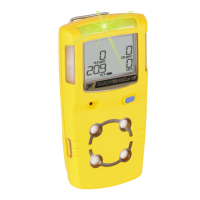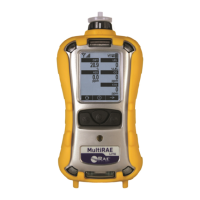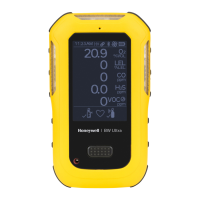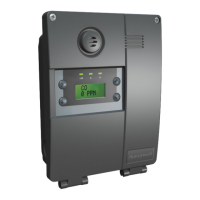Midas
®
Gas Detector
17-2
17 Calibration and Bump Testing
All Midas
®
sensor cartridges are pre-calibrated by
Honeywell Analytics using traceable gas standards
and approved calibration methods to a proven ISO
9000 quality controlled procedure. The Midas
®
sensor
cartridge design is very robust and resistant to long
term drift; in fact in a normal operating environment
it is possible to extend the calibration interval with
Midas
®
up to 24 months (subject to local requirements
concerning calibrations). This design feature is
another element that supports Midas
®
as a long
term cost effective gas detection solution. Honeywell
Analytics recommends frequent bump testing to
confirm performance.
Note
It is the sole responsibility of each user to
determine their own calibration and bump test
schedule based on their own safety assessments
and understanding of local requirements.
Just prior to commissioning, each Midas
®
unit
should be zero calibrated to ensure accuracy. It
is recommended that the unit be powered with
the cartridge installed for at least 30 minutes prior
to conducting a zero calibration. A second zero
calibration may be required after a 24 hour period
which is dependent on the site conditions. O
2
sensors
are not zero calibrated but should be span gas
calibrated. (See Section 7.3.2 for span gas calibration
details).”
If the ambient condition in the area the detector is
monitoring experiences a long-term change, it is
necessary to perform a zero calibration to allow the
unit to adjust to the new conditions.
Note
When performing a zero calibration, be sure
that the area is free of the target gas and/or
interfering gases (refer to the cartridge data
sheets for further details), as the presence of
a background gas will aect the ability for the
detector to properly calibrate to the correct
levels. If the sample area cannot be veried
to be free of the target gas or cross-sensitive
gases, use a cylinder of zero air to perform the
calibration
Calibration of an electrochemical sensor cartridge
is a relatively complex discipline to master and it
is possible that in less ideal field conditions the
calibration can be far less accurate than under
laboratory conditions and therefore substantial
inaccuracies can be introduced. In the absence of
any formal calibration policy by the end user, it is
preferable to retain the original factory calibration.
Care must be taken to ensure that the correct materials
for an extractive application are obtained from reputable
suppliers and are of proven quality and composition.
Inappropriate calibration equipment will lead to under -
or over-presenting the wrong concentration of gas
to the sensor cartridge during the calibration period.
Likewise contaminated or inadequately flushed tubing
and other gas-wet surfaces can also introduce errors
into the calibration process. Only qualified, trained
personnel should attempt to perform gas calibrations;
contact your local Honeywell Analytics Service
Representative for further details on calibration
services.
Testing should be performed at the end of the sample
tube or at the detector with a short length of tubing.
Applying gas with a short length (less than 5 feet/1.5
meters) of clean FEP tubing will give optimal results
for confirming the accuracy and response time of the
cartridge.
